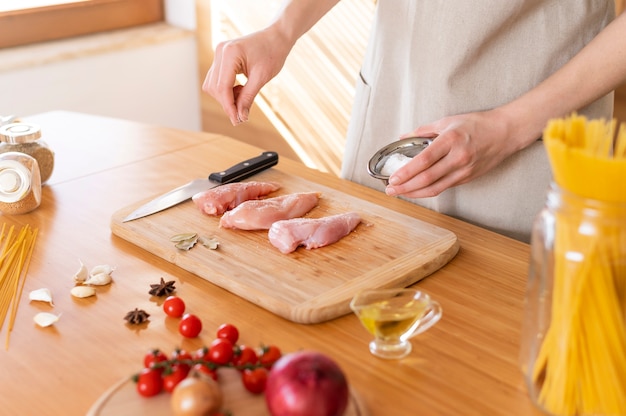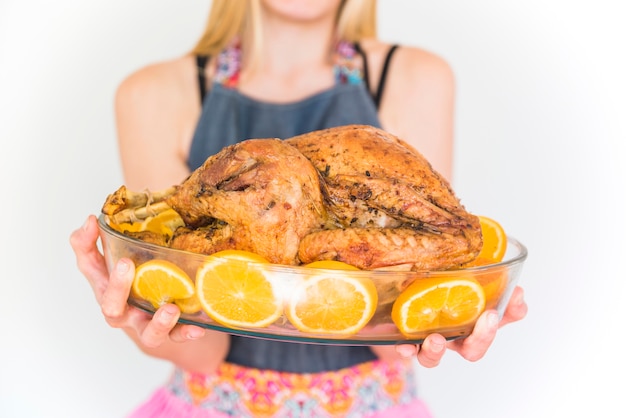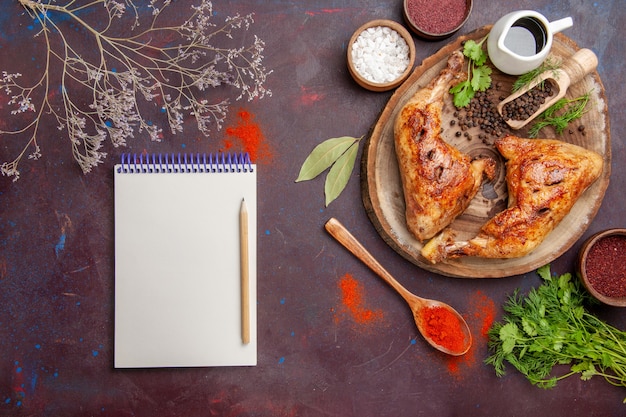As a seasoned home cook, I've learned that nothing beats the satisfaction of creating a delicious meal from scratch. But when it comes to chicken, there's one crucial aspect that can make or break your dish: the internal temperature. You want a juicy, tender, and perfectly cooked piece of chicken, but you also want to make sure it's safe to eat. That's where understanding the perfect internal temperature comes in.
I've been cooking for years, but I used to rely on the "it should be cooked through" rule. However, I realized that's not accurate enough. There's a specific temperature that chicken needs to reach to be considered safe, and that's where a trusty meat thermometer is your best friend. So let's delve into the world of chicken cooking and explore the science behind the perfect internal temperature.
(Part 1) Understanding the Basics

Why Temperature Matters: It's All About Safety
Let's be honest, raw chicken isn't exactly a health food. It's a breeding ground for nasty bacteria like Salmonella. These little critters can cause food poisoning, resulting in some pretty unpleasant symptoms: nausea, vomiting, diarrhea, and those stomach cramps that make you wish you could curl up and disappear. Nobody wants that, right? A good, solid internal temperature ensures these bacteria are destroyed, making your chicken safe to eat. It's not just about deliciousness, it's about protecting your health.
The Importance of a Meat Thermometer: Your Culinary Guardian Angel
Forget relying on the "it looks cooked" method, folks. It's unreliable and can lead to undercooked chicken, putting your health at risk. You need a meat thermometer, and a good one at that. There's a whole world of meat thermometers out there, from simple analog thermometers to fancy digital ones with probes and timers. Choose one that is accurate and easy to use. Personally, I love my digital thermometer with a timer. It alerts me when the chicken reaches the perfect temperature, so I don't have to constantly check on it.
(Part 2) The Magic Number: 165°F (74°C)

This is the temperature that the USDA and FDA recommend for cooked chicken. It's the magic number that ensures your chicken is safe to eat. This applies to all parts of the chicken: breasts, thighs, wings, drumsticks, you name it. No exceptions! You can check the temperature in different spots of the chicken just to be sure. It's better to be safe than sorry, especially when it comes to food safety.
Why 165°F (74°C)?: The Science Behind the Safety
This temperature is crucial for eliminating any harmful bacteria hiding in your chicken. It's the minimum temperature needed to effectively destroy those pesky bacteria, safeguarding your meal and your health. Anything less than 165°F (74°C) means you're playing a dangerous game with your health, and trust me, it's not worth the risk.
(Part 3) chicken cooking methods: Achieving the Perfect Temperature

Different cooking methods require different approaches to reaching that magic 165°F (74°C). Here's a breakdown:
Oven: A Reliable Choice for Safe and tender chicken
When roasting chicken in the oven, it's important to use a meat thermometer to check the internal temperature in the thickest part of the meat, ensuring it reaches 165°F (74°C).
Here's a tip: If you're cooking a whole chicken, make sure to check the temperature in both the breast and thigh, as they tend to cook at different rates. The breast will generally cook faster, so you might need to cover the chicken with foil for a portion of the cooking time to prevent it from drying out.
Grilling: A Summertime Favourite with a Safety Twist
Grilling is a fantastic way to get a crispy skin and delicious flavour, but remember, it's important to check the temperature of your chicken throughout the grilling process. Make sure to check the internal temperature in multiple spots, especially in the thickest part of the meat, and ensure it hits 165°F (74°C).
Grilling can be a bit trickier, as the temperature can fluctuate a bit. I recommend using a meat thermometer with a timer, so you get an alert when your chicken reaches the desired temperature. This way, you can focus on enjoying your grilling experience without worrying about undercooked chicken.
Frying: A Crispy Treat with a Temperature Check
Frying chicken can be a real challenge when it comes to achieving the right internal temperature. You need to ensure the oil is hot enough to cook the chicken without burning it. Use a thermometer to check the temperature of the oil and make sure it reaches the recommended temperature for frying, which is typically around 350°F (177°C) for chicken. Always use a meat thermometer to check the internal temperature of the chicken, making sure it reaches 165°F (74°C) before serving.
Once you've reached the desired internal temperature, be sure to let the chicken rest for a few minutes before carving and serving. This allows the juices to redistribute, making for a juicier and more flavorful chicken. This resting period is key for juicy and tender results.
Other Methods: Poaching, Steaming, and Sous Vide: A Symphony of Safety
No matter the method you use, whether it's poaching, steaming, or sous vide, the golden rule is to always check the internal temperature of the chicken with a meat thermometer, ensuring it reaches 165°F (74°C).
Poaching offers a gentle cooking method that preserves the moisture of the chicken, while steaming delivers a light and healthy option. Sous vide, a technique involving precise temperature control in a water bath, is a great way to achieve perfectly cooked chicken, but even with sous vide, it's still essential to use a meat thermometer to ensure the chicken reaches the safe internal temperature.
(Part 4) chicken safety tips: Preventing foodborne illness
Now that we've covered the basics of cooking chicken to the right temperature, let's talk about a few safety tips to keep in mind:
- Always wash your hands thoroughly with soap and water before and after handling raw chicken. Think of those tiny bacteria as invisible enemies; they can easily spread.
- Wash any surfaces that came into contact with raw chicken with hot soapy water. This includes cutting boards, knives, and utensils. Remember, bacteria can cling to surfaces and transfer to other foods.
- Avoid cross-contamination. Never place cooked chicken on the same plate or surface that held raw chicken. Use separate cutting boards, plates, and utensils for raw and cooked chicken. This helps prevent the bacteria from raw chicken from spreading to cooked chicken.
- Always refrigerate raw chicken promptly. Don't let it sit out at room temperature for more than two hours. Bacteria thrive at room temperature, so it's essential to chill raw chicken as quickly as possible.
- If you're unsure about the safety of chicken, it's always better to err on the side of caution and throw it out. Food poisoning is not worth the risk. When in doubt, throw it out.
(Part 5) Signs of Undercooked Chicken: Spotting the Danger Signals
It's crucial to be able to spot the signs of undercooked chicken. Here are a few things to look out for:
- Pink or red inside. Chicken should be white or a very light shade of yellow throughout. Pink or red indicates that the chicken is not cooked through and may still contain harmful bacteria.
- Juices are pink or red. If you cut into the chicken and the juices run pink or red, it's not cooked through.
- Feels soft and spongy. Cooked chicken should feel firm and springy to the touch. Soft and spongy chicken is a sign that it's not cooked properly and could be unsafe to eat.
If you see any of these signs, it's best to cook the chicken for a bit longer to ensure it reaches the safe internal temperature. Don't be afraid to overcook the chicken slightly; it's better to be safe than sorry.
(Part 6) chicken cooking mistakes to Avoid: Learning from Common Errors
We all make mistakes, and cooking chicken is no exception. Here are some common mistakes to avoid:
- Not checking the temperature. This is perhaps the biggest mistake you can make. Don't rely on looks alone. Always use a meat thermometer to check the internal temperature.
- Overcrowding the pan. This can lead to uneven cooking and the chicken not reaching the safe temperature. Give your chicken some space to breathe, and cook in batches if necessary.
- Not letting the chicken rest. Always let the chicken rest for a few minutes after cooking before carving and serving. This allows the juices to redistribute, ensuring a juicy and flavorful chicken.
- Using a dirty thermometer. Before using your meat thermometer, make sure to clean it thoroughly. A dirty thermometer can spread bacteria to your chicken.
(Part 7) chicken recipes to Try: Putting Your Knowledge to the Test
Now that you have a solid understanding of cooking chicken safely, it's time to put your newfound knowledge to good use. Here are a few recipes you can try:
Roasted Chicken with Herbs and Lemon: A Classic with a Twist
A classic recipe that's always a crowd-pleaser. Simply rub a whole chicken with a mixture of herbs and lemon zest, then roast until it reaches the perfect internal temperature of 165°F (74°C). Serve it with roasted vegetables for a complete meal. The lemon adds a bright citrusy flavour, while the herbs provide an earthy aroma.
grilled chicken with Mango Salsa: Summertime Delight
This recipe is a summer favourite! Marinate chicken thighs in a blend of spices and lime juice, then grill until cooked through and reaching an internal temperature of 165°F (74°C). Top with a refreshing mango salsa for a delicious and healthy meal. The sweetness of the mango salsa perfectly complements the smoky flavour of the grilled chicken.
Chicken Stir-Fry: A Quick and Easy Weeknight Meal
For a quick and easy weeknight meal, try this chicken stir-fry. Simply stir-fry chicken breast with your favourite vegetables and sauce. Remember to check the internal temperature of the chicken to make sure it reaches 165°F (74°C) before serving. This dish is perfect for a busy weeknight, as it's fast and easy to prepare.
Chicken Soup: A Comforting Classic for Cold Days
This comforting classic is perfect for a cold day. Cook chicken breasts in a pot of broth with vegetables, then shred the chicken and add it back to the soup. Ensure the chicken reaches 165°F (74°C) before shredding and adding to the soup. The warmth of the soup, combined with the flavour of the chicken and vegetables, is sure to soothe your soul.
(Part 8) Chicken cooking faqs: Addressing Your Queries
What is the safest way to cook chicken?
The safest way to cook chicken is to ensure it reaches an internal temperature of 165°F (74°C) throughout, using a meat thermometer to check. Always practice proper food safety guidelines, including washing your hands thoroughly and avoiding cross-contamination.
Can I cook chicken to a lower temperature?
It is not recommended to cook chicken to a lower temperature than 165°F (74°C). This temperature is crucial for killing off harmful bacteria, and anything lower puts you at risk of food poisoning.
What happens if I eat undercooked chicken?
Eating undercooked chicken can lead to food poisoning, which can cause symptoms like nausea, vomiting, diarrhea, and abdominal cramps. Symptoms typically start within a few hours of eating the contaminated food, and can last for several days. In severe cases, food poisoning can lead to dehydration and hospitalization.
Can I freeze chicken after it's been cooked?
Yes, you can freeze cooked chicken, but it's best to freeze it within two hours of cooking. When freezing cooked chicken, it's important to ensure it is completely cooled before freezing. Use airtight containers or freezer-safe bags to avoid freezer burn. Frozen cooked chicken can be kept for up to 2-3 months.
Can I reheat chicken more than once?
It's not recommended to reheat chicken more than once. When you reheat chicken, the bacteria that may have survived the initial cooking process can multiply. If you do need to reheat chicken more than once, make sure it is heated to an internal temperature of 165°F (74°C) throughout.
(Part 9) Conclusion: Safe and delicious chicken Dishes Await
Cooking chicken to the right temperature is crucial for both safety and deliciousness. By understanding the importance of using a meat thermometer and achieving an internal temperature of 165°F (74°C), you can confidently prepare delicious and safe chicken dishes. Remember to practice food safety guidelines to avoid cross-contamination and ensure everyone enjoys a safe and enjoyable meal.
So, grab your meat thermometer, follow these tips, and enjoy a world of delicious and safe chicken recipes! Bon appétit!
Everyone is watching

How to Cook Frozen Lobster Tails Perfectly: A Step-by-Step Guide
RecipesLobster. Just the word conjures up images of lavish meals, special occasions, and a taste of luxury. But let's...

Pork Fillet Cooking Time: How Long to Cook It Perfectly
RecipesPork fillet, or tenderloin as it's sometimes called, is a real favourite in our house. It's so versatile, and...

Pigs in a Blanket Cooking Time: How Long to Bake for Perfect Results
RecipesAh, pigs in a blanket. Just the name conjures up images of those delightful little parcels of crispy pastry en...

The Ultimate Guide to Cooking Delicious Frankfurters
RecipesLet's face it, we all love a good frankfurter. It's a classic, simple, and always satisfying. But let's be rea...

Wolf Meat Recipes: A Guide to Cooking Wild Game
RecipesLet's be honest, you don't see wolf meat at your local butcher shop every day. It's a bit of a wild card, but ...
